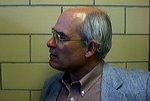Diana Rhoten's recent article in the Chronicle of Higher Education (The dawn of networked science, Vol. 54, Issue 2, Page B12) adds much to the story of how science has developed in the last 100 years.
She provides the following classification of science: bench-top science, big science, team science, and networked science.
Two good examples of bench-top science are Mendel's research on peas and Goddard's research on rocketry. Both were low-budget and conducted alone or in small groups.
 Here's a picture I took at the Air and Space Museum in Washington, DC showing one of Goddard's early rockets (that's Robert Goddard in the background). He and his collaborators used to drive out to the country with their disassembled rockets in the back of a pickup truck. They would put the rockets together, shoot them off, and sometimes had to run from local farmers afterward.
Here's a picture I took at the Air and Space Museum in Washington, DC showing one of Goddard's early rockets (that's Robert Goddard in the background). He and his collaborators used to drive out to the country with their disassembled rockets in the back of a pickup truck. They would put the rockets together, shoot them off, and sometimes had to run from local farmers afterward.After World War II, rocket science became a part of big science. The United States government captured many German V-2 rockets along with many scientists and began a major research project in rocketry. That research led to ICBMs and to manned spaceflight. If it costs a few million dollars or more, it's probably big science.
Big science not only costs lots of money, it also requires a top-down infrastructure. Rhoten notes research such as the Manhattan Project and the Hubble Space Telescope as examples of big science.
Team science, she says, "is often centered on researchers whose main ties are to the given intellectual challenge." (and not to a particular institution). An early and successful example of team science is the Human Genome project. In that research, scientists from many disciplines from laboratories all around the world collaborated to solve a particular problem. They did so ahead of schedule and under budget.
Networked science is emerging now thanks to advanced computer technologies and networks. New and virtual entities such as InnoCentive and the Biomedical Informatics Research Network offer opportunities for scientists everywhere to solve problems (and get paid for it). Rhoten cites the case of Edward Melcarek. He is a scientist who works on problems for InnoCentive. Click here for a Wired.com article on Melcarek.
Networked science may offer a mechanism to return to a model more similar to bench-top science than to big science.



No comments:
Post a Comment